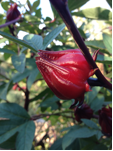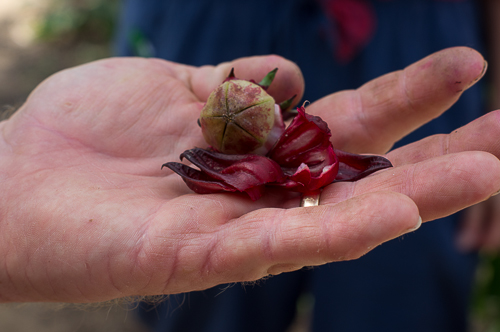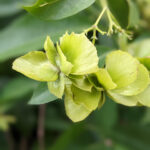Botanical Name: Hibiscus sabdariffa L.
Family Name: Malvaceae
Common Name(s) – roselle, Jamaica, Jamaica sorrel, red hibiscus, zinger hibiscus, red-sorrel, rosella (Australia), maple leaf hibiscus, Florida cranberry, October hibiscus, and karkadé (in some Middle Eastern countries and notably Egypt)
Origin – Africa (Angola), but long cultivated in all tropical regions, especially in North Africa, Mexico, India, Thailand, and China – currently the major production regions.
Growth Habit – An upright annual (temperate regions) or woody perennial (tropical regions) that can reach up to 4m in height, but which is more commonly about1-2 meters tall and wide.
Leaves – Lobed (often three), green, sometimes with red venation, and alternate on the stem.
Flowers – Of the common hibiscus form with creamy yellow petals (other colors are possible) and dark burgundy splotches at the petal bases – approximately 3 inches in diameter. The flowers are quite short lived – normally only lasting one day. After the flower fades the calyx and epicalyx (a whorl of bracts that resembles a second row of sepals) swell and become a rich, deep red in color.
Growth (Cultural) Requirements – Full sun with lightly moist, fertile soil. Roselle is a short day plant and photoperiodic. It needs a fairly long season to mature, so it should be planted as soon as it is warm enough in the spring. In northern temperate regions it may not have a long enough season to mature, but here in zone 8-9 we have a long enough season to grow it successfully and get a crop.
Propagation – seed (most common and very easy) or cuttings
Plant Part(s) Used – This is an unusual plant in that the main part used is the calyx, which swells up and become a rich, deep red as the seed pod matures. The calyx can be used in either a fresh or dried (more common) form. This material, sometimes known as Hibisci flos, is most commonly used to make tasty, healthy teas and beverages. The leaves can be used as a leafy vegetable, the stems of mature plants, especially those of tropical regions, are a source of fiber known as rosella hemp, and seeds also have culinary uses.The flowers of Chinese hibiscus (Hibiscus rosa-sinensis) are edible, but not notably tasty.
Time of Harvest – Calyx – when vividly red and before the seed pod matures and dries – normally in the fall in temperate regions. Sometimes the calyx is not removed and is sold dried with the seed pod still intact. The calyx is also sold in a removed and dried form – the sepals are sepated and sold either whole or cut and sifted.
Medicinal Uses – Most commonly used internally as a tonic tea to aid digestive and kidney function. (Bown)
Traditionally used to treat appetite loss, colds, catarrh of the respiratory tract, circulatory ailments, and as a gentle expectorant, laxative, and diuretic.(Van Wyk and Wink)
Culinary Uses – The calyces are commonly used to flavor a variety of beverages. In Mexico and Central America a punch called Agua de Jamaica is often made. It is commonly made by steeping the dried calyces in hot water and adding sugar as a sweetener. It is also sometimes amended with flavors such as ginger and lemon or lime juice.
The calyces can also be used to make jams, curries, chutneys, and cranberry-like sauces or syrups. (Bown)
The dried calyces are powdered and used as a topping in Asian dishes, lending a distinctive burgundy color. (Hill and Barclay) The leaves have a rhubarb-like flavor and can be eaten raw or cooked. (Bown) The seeds can be eaten roasted, made into an oily sauce, or fermented to make a Sudanese meat substitute called furundu.(Bown)
Other Uses – The fibers of the stems can be used as a bast fiber and are at times use to replace jute in the making of burlap. (Wikipedia) Growing interest is being shown in its potential use as a safe food colorant.
Bibliography – Bown, Deni 2001 NewEncyclopedia of Herbs & Their Uses London: DK Publishing
Hill, Madalene and Gwen Barclay 1987 Southern Herb Growing Fredericksburg, TX: Shearer Publishing
Van Wyk, Erik and Michael Wink 2004 Medicinal Plants of the World Portland: Timber Press
http://en.wikipedia.org/wiki/Roselle_(plant)
(It is the policy of The Herb Society of America not to advise or recommend herbs for medicinal or health use. This information is intended for educational purposes only and should not be considered as a recommendation or an endorsement of any particular medical or health treatment.)
-Henry Flowers, October 2012











